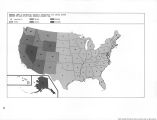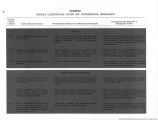| OCR Text |
Show Access Road Construction Recommendation 33: There should be an accelerated program of timber access road construction. The practice followed by the public land management agencies of having timber access roads constructed in large part as an adjunct of timber sales has limited the construction of those roads. By requiring timber operators, who are not, or do not desire to become, road builders, to handle road construction activities, the agencies have also limited some legitimate operators from obtaining public timber sales. In many instances roads are required to a standard higher than necessary merely to harvest timber. Agency reliance on purchaser-built timber access roads has a number of other serious disadvantages. First, road development must be keyed to timber sales which can lead to inefficient design and size specifications. Second, it can lead to undesirable harvest schedules. And third, lack of suitable access road networks has made salvage of dead or dying timber impossible as well as inhibiting measures to control or present disease and fire losses. Timber saved as a result of suitable access would be reflected subsequently in net growth computations and allowable cuts. The Commission believes that a "catch-up" program of access road construction must be authorized and supported with appropriations. These access roads would make available merchantable timber within the dominant timber production units recommended above. The initial funding for these roads will have to come either from direct appropriations from the Treasury, or from the revolving fund we have proposed, if that fund in its inception is granted borrowing authority. In addition, by making these new areas available for the protection, management, and harvesting of public land timber, this accelerated road program, which we believe could be completed in a 10-year period, would each year permit the salvage and sale of considerable timber that must now be abandoned after it has either fallen or been blown down. As part of the protection of the lands, these roads would provide access for fire, insect, and disease control. It would also allow the agencies to make economic investments and carry on management programs in areas that cannot be reached now. Finally, it would simplify existing timber sales programs by separating road construction from timber harvesting, and eliminating allowances for road construction costs from the timber sales procedures, a practice we suggest earlier in this chapter as one to be ended. Dependent Communities and Firms Recommendation 34: Communities and firms dependent on public land timber should be given consideration in the management and disposal of public land timber. Many communities and firms, particularly in the western United States, are dependent on public land timber. If the public lands were suddenly eliminated as a source of timber, some of these communities and firms would cease to exist. Others would experience very difficult times. Through its timber management and sales policies, the Federal Government over the years has in effect made a commitment to communities and firms that it will make timber available to assure their continued existence. The provision of the 1968 Foreign Aid Act9 that limits exports of logs to Japan from the western public lands and the long-standing primary processing requirement for timber harvested from the national forests in Alaska 10 are examples. The Small Business Administration set-aside program to limit eligibility for some timber sales to firms having less than 500 employees is an example of a regulatory commitment to small firms.11 The Commission recognizes that changes are continually taking place both in the structure of the timber industry and in the viability of particular firms and communities. But we also recognize that the Federal Government has an obligation to those who depend on public lands for their livelihood. Federal policy should be directed at achieving a balance between healthy change and the assurance of opportunity for existing users and communities dependent on Federal timber. The use of a procedure whereby timber "quotas" were allocated to dependent areas was attempted in the past to provide an assured supply of timber to firms in each designated area. The Sustained Yield Unit Act of 1944 12 provided a statutory basis for assigning quotas to areas established under that Act. A number of units were established, one of which involves joint consideration for management purposes of public and private timberlands in an area. We have found that these attempts to use quotas as a means of assuring timber supplies to a firm or an area have not been entirely successful. Their usefulness is limited by changing conditions. Obviously, where there is a limited timber supply, the allocation of timber to one firm restricts the opportunities for another. The long-term commit- 9 16 U.S.C. § 617 (Supp. V, 1970). 1O36C.F.R. §221.3(c) (1970). 11 George Banzhaf & Company, Public Land Timber Policy. PLLRC Study Report, 1969. 12 16 U.S.C. §§ 583-583i (1964). 99 |







































































































































































































































































































































































